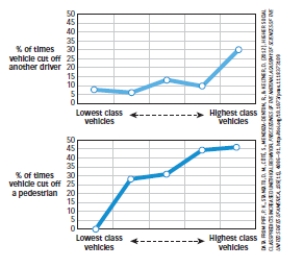Use the following to answer questions
Scenario I
Scenario I is based on and presents data from the following study (reproduced from p.25 of the textbook) :
Piff,P.K. ,Stancato,D.M. ,Côté,S. ,Mendoza-Denton,R. ,& Keltner,D.(2012) .Higher social class predicts increased unethical behavior.PNAS Proceedings of the National Academy of Sciences of the United States of America,109(11) ,4086-4091.doi:10.1073/pnas.1118373109
Piff and colleagues (2012) used naturalistic observation techniques to determine if wealthy people behaved more or less ethically than people who were not wealthy.In one study,observers stood at a busy intersection and recorded the make,model,and year of each approaching car.They also noted if the car cut off other cars or pedestrians at this intersection.
Major findings of Piff et al.(2012) are presented in Figure 1.1.This figure shows the percentage of times vehicles cut off another driver (top panel) or pedestrians (lower panel) as a function of the social status of the vehicles (with more expensive cars ranked higher in social status) .
Figure 1.1 
-(Scenario I) Consider both panels in Figure 1.1.Which is a description of a result shown in this figure?
Definitions:
Free Black Men
African American men who were not enslaved, focusing on their lives, rights, and contributions to society during various historical periods.
Voting
The act of formally expressing one's choice or opinion in an election or decision-making process.
1860
The year notable for the election of Abraham Lincoln as President of the United States, leading up to the Civil War.
Q9: (Scenario I)A psychologist believes that driving expensive
Q55: The tendency for a measure to produce
Q76: The extent to which a concrete event
Q81: In a normal distribution,the peak of the
Q121: Within psychology,psychoanalysis had its greatest influence on:<br>A)cognitive
Q145: A bathroom scale is broken and always
Q154: A college dean is interested in measuring
Q173: Which research question is MOST consistent with
Q217: In the number sequence 3 6 1
Q263: Juliana wonders if males or female college